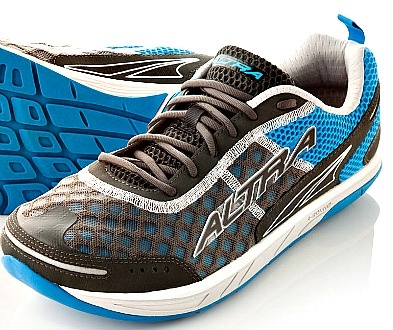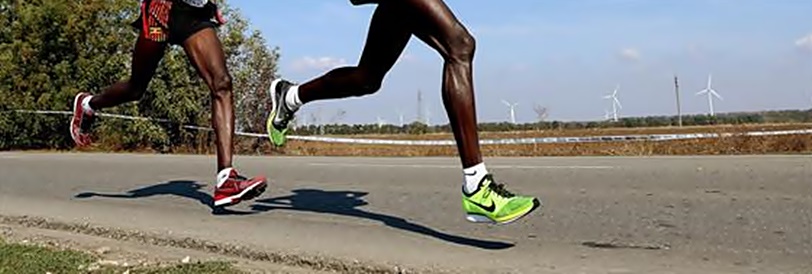When we run, our running stride has the ability to absorb impact and store loads of elastic strain energy for greater efficiency. In fact, our running stride is best described as an integrated spring-mass system where according to Dr. James Stoxen DC, the foot acts as a spring suspender that protects the body from high impact by springing the body off the ground, not pushing it like heel strike runners do.
Also, the spring loading of the foot during running allows the tendonous structures of the leg to fill up with elastic strain energy. However, the spring suspension behavior of the foot is noticeably optimized when running barefoot via a forefoot strike landing, but is perturb when a thick cushioned shoe is worn.
Footwear can have dramatic effects on your running stride. Too thick running shoe cushioning hinders running performance by perpetually reducing foot/leg spring during forefoot running.
Thick Cushioned Footwear Makes Your Running Stride Less Efficient
First lets quickly define what I like to call ‘leg spring’ and why it is important in forefoot running. Leg spring refers to the elastic energy storage capacity of the Achilles tendon whereby a higher leg spring means more energy is stored within the tendon and is subsequently converted into kinetic energy during forefoot running. Overall, to run with greater efficiency, you want to maximize your leg spring.

But consider this:
- The degree of leg spring during running hinges on stance phase duration, or ground-contact time, which is strongly influenced by shoe cushioning.
Morin et al. found that a 10% increase in stance phase duration reduced leg spring by 25%. Based on their data, the researchers concluded that stance phase duration was the most important parameter that affects leg spring.
Further, Chambon et al. found that a 16mm of midsole thickness increased stance phase duration by 5% which resulted in a 10% reduction in leg spring when compared to running barefoot.
So, how do maximum cushioned running shoes negatively affect leg spring?
- Chambon et al. reasoned that thicker midsoles slows the progress of the foot segment towards the ground after touchdown, accounting for the increase in stance phase duration and the reduction in leg spring.
- Thicker midsoles may require more time to compress causing the foot to remain in contact longer with the ground.
Therefore, to improve running efficiency, stance phase duration must be kept to a minimal, so that the leg is in a better position to behave more spring-like. This can be attained by running barefoot or in barefoot like running shoes.
Run Barefoot, Spring Better
An extensive body of research supports the effectiveness of running barefoot or in barefoot-like footwear on reducing stance phase duration and increasing leg spring to fuel better performance.
Likewise, elite distance runners who ran barefoot during early development are the ones who outperform elite runners of habitually shod populations, suggesting that chronic exposure to barefoot running results in significant adaptations to a running style that optimizes leg spring.
How Barefoot Running or Pure Minimalism Injects More Spring to Your Stride
In the absence of compressible midsole material, the vertical displacement of the center of mass (i.e running with a bounce) is lower.
- A lower vertical displacement of the center of mass, as observed in barefoot runners, is associated with heightened leg spring. In other words, you may feel ‘springer’ and ‘more responsive’ in thicker midsoles, but the Achilles tendon is not loading fully with elastic energy. This is due to the fact that midsole thickness alters foot strike from a forefoot strike to heel strike.
Many experts argue that a forefoot strike is a major component for inducing greater elastic energy storage in the Achilles tendon, affording those who ran barefoot earlier on in life a competitive advantage.
More From Run Forefoot:
- Myths on Therapeutic Tape for Running
- Transitioning Exercises for Forefoot Running
- Worst Injury Associated with Heel Running
- Minimalist Shoes for Forefoot Running
References:
Chambon et al. Is midsole thickness a key parameter for the running pattern? Gait & Posture, 2014; 40:58-63.
Morin JB, Dalleau G, Kyro¨la¨inen H, Jeannin T, Belli A. A simple method for measuring stiffness during running. J Appl Biomech 2005;21:167–80.
Morin JB, Samozino P, Zameziati K, Belli A. Effects of altered stride frequency and contact time on leg-spring behavior in human running. J Biomech 2007;40:3341–8.
Bretta Riches
BSc Neurobiology; MSc Biomechanics candidate, ultra minimalist runner & founder of RunForefoot. I was a heel striker, always injured. I was inspired by the great Tirunesh Dibaba to try forefoot running. Now, I'm injury free. This is why I launched Run Forefoot, to advocate the health & performance benefits of forefoot running and to raise awareness on the dangers of heel striking, because the world needs to know.
Latest posts by Bretta Riches (see all)
- Are Minimalist Shoes Good for Seniors? YES! - 14/04/2024
- BIG Deals On Running Gear And More! - 09/04/2024
- Why Are My Feet Tired After Running? - 04/04/2024


in her wonderful poem you are The Best!It was so wonderful to meet you at BC. Hope you have a fantastic birthday and many more! Hug and love in dulpoinghomd.